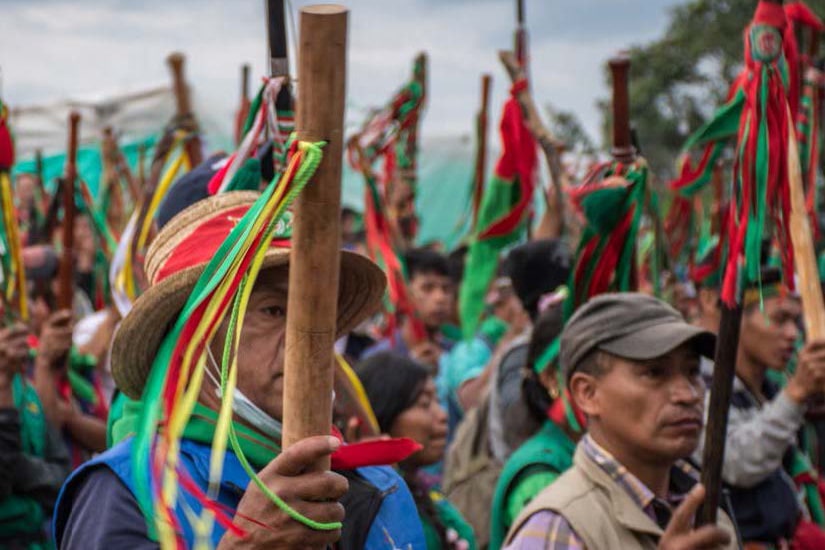Peace in Colombia has been on Latin America’s political agenda for decades. The very opposite of peace has been foisted upon the country by the United States through Plan Colombia (2000) and through the installation of seven foreign military bases on Colombian territory. People’s movements, on the other hand, have been witness to efforts to reach peace through intense negotiations. For Colombia and for the people of Latin America–Our America–‘peace’ has become the central axis of the dispute between neoliberalism (and its military component) and popular aspirations.
For the forces of the far-right, support for war and for the war economy provides an advantage for their economic and political interests. The current context is marked by numerous assassinations of leaders of social movements and community organisations, and by an official discourse that ceaselessly attacks the Bolivarian Republic of Venezuela. This attack on Venezuela threatens to promote destabilization not only through this discourse, but also through military intervention that would provoke a regional war.
Results from the regional and municipal elections held at the end of October suggest the decline of the authority of Ivan Duque’s far-right government. Opposition political parties won several elections at the municipal level–particularly in Colombia’s major cities, including the capital city of Bogotá. This victory of the opposition suggests the weakness of the coalition created by Duque and former president Álvaro Uribe. It was this coalition that won Duque the presidency in June 2018. Duque came to power with a war-like agenda; he was against the peace negotiations that had been taken seriously by his predecessor, Juan Manuel Santos.
Once again, the people of Colombia straddle two realities–the drums of war and the hope of peace. This tension has along, complex, and multi-dimensional historical process. This dossier from Tricontinental: Institute for Social Research examines the root causes of the crisis and the two realities of war and peace.
This dossier was prepared by the Group of Colombian Critical Thought at the Institute for Latin American Studies (Grupo de Pensamiento Crítico Colombiano del Instituto de Estudios de América Latina y el Caribe or IEALC) at the Faculty of Social Sciences at the University of Buenos Aires. We would like to thank the researchers of this collective for their collaboration with Tricontinental: Institute for Social Research.
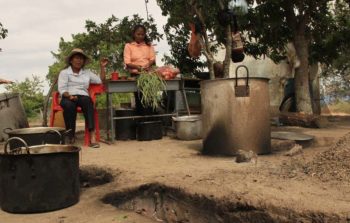
Mobilisation in Catatumbo, Department of North Santander.
Peasant Association of Catatumbo — Ascamcat.
The Long Path of Peace and Social Change
Extreme inequality, the concentration of land ownership, and obstacles to political participation are at the heart of the social, political, and armed conflict in Colombia.
The Colombian economic model is centred on three major industries–mining, agriculture, and cattle. Transnational firms dominate the mining sector, while agriculture and cattle are subordinated to the global value chain.
In terms of land distribution, Colombia is the most unequal country in Latin America. According to the national census of agriculture, 81% of Colombian territory is owned by 1% of the population, while the remaining 19% is in the hands of the 99%–mainly peasants (Censo Agrario 2015). These conditions of poverty in rural areas have the largest impact on women, who possess a mere 26% of land titles and–in practice–do not have a right to health, housing, or education. According to Oxfam, a million rural families in Colombia live in quarters that are smaller than the space that a cow has to graze (Oxfam 2017).
Social inequality is mirrored by political inequality. In Colombia, political participation of people’s movements and democratic forces is limited. The State stigmatizes, persecutes, and assassinates people who subscribe to left or oppositional ideological currents, as shown by the systematic assassination of social leaders (Indepaz 2018).
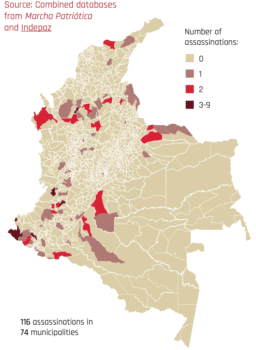
The number of those assassinated in November (2019) continues to rise. By 1 October, 155 deaths had been registered, concentrated in the same areas shown in this map.
Social Leaders and Defenders of Human Rights Assassinated in 2019 (1 January–26 July)
The Cold War, followed by the implementation of a hybrid war through Plan Colombia, furthered the practice of physically eliminating social organisations, movements, and political parties–especially among the left. In 1984, after the first peace accord between the State and the Revolutionary Armed Forces of Colombia (Fuerzas Armadas Revolucionarias de Colombia or FARC), the left formed a political platform known as the Patriotic Union (Unión Patriótica). A political genocide was carried on against the people who were associated with the Patriotic Union: for instance, four thousand students were killed in the 1980s and 1990s (Cepada 2006). Today, this violence is being experienced once again. In 2018, the Center for Research and Popular Education Peace Program (Centro de Investigacion y Educacion Popular Programa Por La Paz or CINEP) documented 1,151 death threats, 648 assassinations, and 304 cases of physical injuries as well as numerous cases of harassment (CINEP 2019).
In 2016, under pressure from a growing popular movement for peace, the Colombian State and the FARC signed a new peace accord. This Accord came after four years of negotiation and is organised around six main points:
- Undertake comprehensive rural reform by land redistribution. A trust of three million hectares has to be given to peasants, indigenous peoples, and Afro-Colombians. The Accord sets up the basis for the creation of development programmes that are required to partner with rural organisations.
- Build peace through the incorporation of all parties into the democratic processes. The Accord creates a Statute of Opposition that is dedicated to guaranteeing the rights of social movements, grassroots movements, and political parties to participate in the full range of political activity.
- End the conflict by a ceasefire and by laying down arms.
- Create a collective and comprehensive solution to the illegal drugs problem.
- Create a truth, justice, reparations, and non-recurrence system that both looks back at the violence and looks forward to it not reappearing.
- Creation of a commission for monitoring, promoting, and verifying the implementation of the final agreement (Peace Accords 2016).
Two subsections of this agreement have not been implemented: (1) to create a Special Transitory Peace Electoral Districts (Circunscripciones Transitorias Especiales de Paz or STPED) that would incorporate sixteen representatives of the people’s movements into the Congress; (2) structural reform of the political system.
The extent of the Accord’s proposed reforms and their political implications have provoked fierce resistance from the political and economic sectors who benefit from the entrenched inequality,
the rentier model of the economy, and the commercialisation of agriculture. Reports by the United Nations and the Kroc Institute (University of Notre Dame) suggest that the implementation of the Accords has been very slow. This has had a negative impact on the Colombian people–especially on the former combatants. A comprehensive and efficient implementation of the Accords would open up possibilities to strengthen a political and economic alternative in Colombia and would embolden the popular forces and reinforce the left’s role in the class struggle. Faced with this possibility, the far-right and militaristic forces–which includes the national government–have been an obstacle to the implementation of the Accords and have refused to build comprehensive and genuine peace.
It is in this context that the assassinations of the social leaders have increased.
From the 2016 Accords to the 2019 Elections: The Struggle for Peace
For decades, Colombian politics have been disorientated by the oscillation between war and peace, which has side-lined the struggle against neoliberal economic and social policies. In this context, the right-wing political forces and the State–backed by foreign powers such as the United States–have promoted a military exit to the internal armed conflict. However, the struggles of popular movements have strengthened the efforts for peace and pushed for a negotiated settlement to the conflict. The success of the popular movements in this regard has resulted in a calmer emotional response to the war, which has expanded the peace camp that calls for an end to war through dialogue and negotiation rather than through an escalation of military action.
Though the movement for peace has achieved this crucial victory of shifting the political understanding of the war, the militaristic sections–such as the parties of the right-wing and the institutions of the State–persist. Decades of popular struggle have put a comprehensive notion of peace on the table. This notion of peace was shaped to include all insurgent forces, to open the doors to a wide understanding of democracy, and to allow all communities to be part of the democratic process (including the peasantry and agricultural workers, victims of the war, women, dissidents, and precarious urban workers). The political thesis of the peace bloc was to drive an agenda not to merely end the war, but to displace war as the central axis of national politics; it was to replace an obsession with war with the project to rebuild citizenship and change the prevailing social order. In other words, a key part of the foundation of this approach to peace is to supplant the project of militarized neoliberalism with a peaceful political and economic project (González Casanova 2013, Seoane 2016).
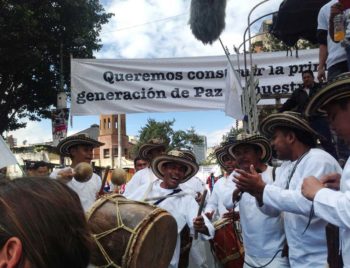
Mobilisation in Barranquilla, Department of Atlántico.
– Marcha Patriótica’s communication team.
The political landscape in Colombia began to change in 2016. It was in that year that the State and the FARC signed the Peace Accords and it was then that they began a dialogue with the National Liberation Army (Ejército de Liberación Nacional or ELN). Colombian voters were polarized between those who support the Accords and those who do not (not all of those who were against the Accords were against peace; rather, they had differences with parts of the agreement). The movement for peace suffered a partial defeat in the 2016 referendum, when this polarization went in favour of the forces of militarism. The rejection of the Accords in the referendum mandated a process of revision of the Accords by the Congress.
Two years later, as the Accords were in the process of being implemented, Iván Duque won the 2018 elections. Former president Uribe had emerged as one of the leaders of the bloc that stood against the Peace Accords and for a militaristic exit from the conflict in Colombia, and Duque was part of his right-wing coalition. But Duque could not win the election in the first round. It is significant that, for the first time in the history of Colombia, a left-wing candidate–Gustavo Petro–advanced to the second round of the elections. He won more than 8.2 million votes–41.8% of those who voted in the second round. This electoral feat challenged the power of the political system installed in the nineteenth century; it confirmed the view that change was in the air, as a significant segment of the Colombian population was willing to challenge the hegemony of the right-wing and of the camp of war.
On 27 October 2019, regional and municipal elections showed the strength of those who stand for peace against the country’s right-wing and those who stand for war. Colombia’s major cities (Bogotá, Medellín, Cali, Cartagena, Cúcuta, Bucaramanga, and Manizales) will now be governed either by independent factions in the traditional parties that have progressive tendencies and are committed to democracy as well as peace, or by candidates from progressive parties. This reflects a political break. ‘Peace’ has now come to be defined by a broad concern for the expansion of social programmes. Only in small to medium municipalities where conservativism remains dominant did the clientelism and traditionalisms of the past prevail.
The election results do not directly benefit the former guerrilla combatants, although some of them have been successful in reaching city hall and in gaining legislative representation. The FARC has already been seated in ten of the sixteen seats in Congress, as designated by the Peace Accords. From city hall and from Congress, the progressive forces and the camp of peace have a pathway to challenge the previous consensus around militarized neoliberalism. However, powerful forces–led by President Duque–are not easily moved aside. In the October elections, twenty-one candidates from various parties were assassinated and, in various parts of the country, voter turnout was suppressed through the violence of the camp of war. These forces want to maintain militarized neoliberalism. They continue to disrupt peace.
Extractivism, Militarization, and Alternatives
The Peace Accords between the State and the FARC aim to widen the range of political discussion and to deepen the democratic possibilities for the population. To expand the discussion implies allowing a debate around the economic model that sustains Colombia’s political system, which is controlled by powerful factions of the dominant classes. This economic model–armed neoliberalism–reproduces structural inequality and systematic poverty, creating the basis for permanent social conflict.
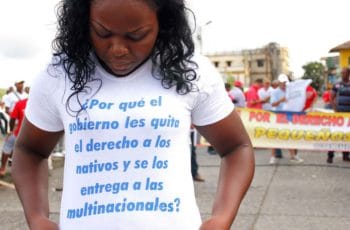
‘Why does the government take away rights from native people and give them to multinational corporations?’
Mobilisation in the Department of Cauca, 2013.
– Marcha Patriótica’s communication team.
There are at least four parts to the political economy of contemporary Colombia:
- Militarization and repression justified by the idea of an internal enemy.
- Coercion of the citizenry through the collusion of the State and the paramilitary forces in the territories that of economic interest.
- Promotion and maintenance of neoliberal structural adjustment policies.
- Boycott of the implementation of the Peace Accords by the national government.
Three socio-economic initiatives of the dominant classes benefit from these four elements of the political economy of Colombia:
- The use of fracking.
- The promotion of large-scale mining.
- Punitive action against cultivators of coca leaves.
These actions aggravate the causes of the armed conflict and increase the inequality that is inherent in the economic model of armed neoliberalism. While the first two initiatives–the use of fracking and the promotion of large-scale mining–reinforce economic financializing, the third initiative–punitive action against cultivators of coca leaves–exacerbates the militarized ‘War on Drugs’ imposed by the United States. Such an assault on the countryside will lead to internal migration, which will exacerbate inequality and poverty in cities, where 85% of workers earn less than 500 U.S. dollars per month (DANE 2018).
The economic and political orientation of the Colombian State is based on the systematic abandonment of precarious workers both in cities and in the countryside; this model leads to a deepening of poverty amongst indigenous communities, peasants, and Afro-Colombians. Colombia is a large country, which has an area of 1.13 million kilometres. Significant parts of this territory are isolated–with few roads–and therefore the country itself is not territorially integrated. Control over this tense social landscape has been maintained not only by State violence, but also by the prevalence of paramilitary forces (Molano 2015). As a con- sequence of this model of dispossession, 26.6% of the Colombian population lives in rural areas. Of them, 45.6% live below the poverty line (Censo agrario 2015). Rural Colombia struggles from extreme poverty, especially amongst Afro-Colombians and indigenous communities. Inequality in Colombia is the second highest in the hemisphere (Gini coefficient of .53), second only to Haiti (Gini coefficient of .60). The impoverishment and inequality in rural Colombia provide important context for understanding the prevalence of cultivators of coca leaves, poppy, and marijuana. The assault on these illegal drugs is a renewed assault on the poor.
Neoliberalism, driven by foreign intervention, has encountered fierce resistance. Popular organisations and social movements are fighting back by mobilising and leading important struggles against large-scale mining, for the right to clean water, and for a State-funded programme to replace illegal crops with legal crops. They are fighting for dignified work, for democratic politics, and for an end to the militarization of their land (see the map on large-scale mining). These struggles are both territorial and social; they are grounded in the defense of land and of common goods, and for the sovereign production of food.
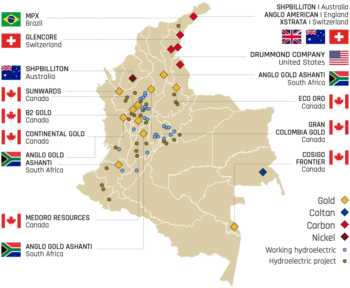
Titles and Requests for Mining Concessions and Major Companies – Action Network Against Extractivism
Peasant struggles are geared towards overcoming the neoliberal model that creates inequality and poverty. New proposals for genuine agrarian reform focus attention on food sovereignty as an antidote to the cultivation of illegal crops. Various regions of the country have already succeeded in this transformation. Peasant Reserve Zones (Zonas de Reserva Campesina or ZRCs) and Agricultural Development Zones (Zonas de Desarrollo Agroalimentario or ZDAs) are the most notable and successful collective proposals promoted by projects for food sovereignty that are based on collective land ownership and models of self-sufficiency. There are now six established ZRCs that are built on a total of 831,000 hectares in six departments of the country; an additional seven ZRCs on a total of 1,253,000 hectares await recognition by the State. In 2014, a summit was held to unify the myriad of popular rural struggles in the country. The process that emerged as a consequence of this summit now represents the most dynamic part of Colombian social movements, and the most active one that searches for a political solution to the armed conflict and to armed neoliberalism.
The perspective that sees peace as part of the transformation of the rural economic model presents a promising possibility for finding an exit from neoliberalism. If the Colombian people can win the struggle for peace, with democratic guarantees, it will only be if the rural economic model remains at the centre of the counter-hegemonic struggle. Land remains a central point of contention: if land remains merely a factor of capital accumulation and financialization, then it will remain a force of war; if it can become the soil upon which generations of frustrated hopes can develop their aspirations, then it will be a factor of change.
The Geopolitics of the Internal Armed Conflict
Colombia has become an important site for the regional geopolitical dispute in Latin America. The United States has utilized Colombia as a key partner in the fight to defeat progressive and anti-imperialist governments in the region. Eagerness to break out of a series of permanent financial crises (such as the global shock of 2008-09), and of a systematic crisis of U.S. hegemony, has led to a renewed assault on Latin America. The U.S. and its allies have positioned themselves to intervene through hybrid wars–such as soft coups, lawfare, and soft power (including development aid). In Colombia, this hybrid war took the form of the War on Drugs–an attack on illegal drug production that covered up the true aim: to suffocate popular struggles and open the door for transnational corporations to exploit mineral and energy resources as well as Andean-Amazonian biodiversity.
Colombia’s dominant class, with the support of the United States, turned the country’s internal war into the basis for intervention into popular struggles in the region. Accusations from the Colombian State and the United States that the Bolivarian Republic of Venezuela was assisting the FARC and other groups hinted at the possibility of a regional hybrid war. These threats of intervention into Venezuela from the Colombian border were intended to demoralise the Venezuelan population. The general theory of the Colombian State and the United States is that the defeat of the Bolivarian project would make it difficult to create an emancipatory project in the region that has the capacity to threaten the interests of the U.S. and of the regional bourgeoisie. That is why both the Colombian State and the United States believe that it is vital to defeat the Bolivarian project. The armed conflict within Colombia, therefore, is a key pragmatic opportunity for both the United States and the Colombian State.
The armed conflict began in the 1960s as part of the struggle that emerged against the installation and development of advanced capitalism in Colombia. The United States intervened through the Inter-American Treaty of Reciprocal Assistance (TIAR) in 1948 and the Alliance for Progress in 1961 as well as in the missions of economic and military experts into the country. Not only did these projects exacerbate inequality and suffering–they also appeared as the solution to those problems. This was the result of imperialism’s success in the battle of ideas. The conditions had been developed for the dominant classes, the armed forces, and a civil society under the cultural hegemony of the United States to favour the imperialist plans and actions in the country, and in all of South America. The dominant classes and the ruling blocs in both Colombia and the United States then insisted that the armed conflict could only be ended by a military victory. Towards this end, those who created the problem then insisted in installing the most sophisticated military plan ever imposed on the region–Plan Colombia (2000). This Plan called for the strengthening of the armed forces, and for the implementation of a full-scale project of repression.
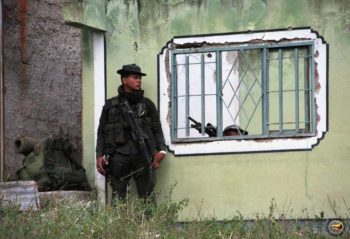
Village of El Mango, October 2015, Department of Cauca. – Marcha Patriótica’s communication team.
Since 2001, the U.S. government has made an evaluation that the balance of forces in the internal armed conflict poses a real threat to the Colombian State (Marcella, Wilhelm 2001). This worry has been amplified by the advances made by the regional Bolivarian project that is anchored in Venezuela. Military and political intervention from the United States into Colombia increased over the decade after 2001. By 2011, it was clear that, far from being resolved, the armed conflict had reached an impasse: neither side could win, and neither side would surrender to the other. This was despite the fact that the Colombian State’s forces had been bolstered by foreign aid to achieve technical superiority and it was despite the fact that it used this superiority to inflict harsh blows on the insurgents. This impasse led to the conversations that would eventually culminate in the Peace Accords of 2016. Colombia’s ruling classes had come to rely upon U.S. military and political ‘assistance’ to maintain their own dominance over the social tensions inside Colombia. This reliance contributed to the Colombian State submitting to U.S. plans to destabilise neighboring Venezuela.
A dependent military-industrial complex has been created in which private Colombian, Israeli, and U.S. companies benefit from the relatively secure commercial activity related to the sale of weapons, logistics, and technical capacity. Colombia spends 13.1% of its national budget on the security sector. The business logic of war imposes itself onto any political attempt to create a pathway to peace. The Colombian armed forces and their private partners are enmeshed in commercial gain through the manufacturing of armaments (guns, explosives, missiles), of methods to fire these weapons (drones, patrol boats), and of mechanisms for information (radars); the armed forces are obligated to purchase various parts of their systems from their business partners in the United States and Israel. These components, such as cyber-security and training modules, are part of the arsenal for the hybrid war–not just against the guerrillas–but also for the hemispheric challenges prioritized by the United States. These priority targets include the governments of Bolivia, Cuba, and Venezuela, and the increased links between the Latin American countries and other powers (notably the RICS–Russia, India, China, and South Africa).
In 2017, Colombia joined the North Atlantic Treaty Organisation (NATO) as a ‘global partner’; it is the only Latin American country in the alliance. This has deepened the Colombian State’s role in the United States’ geopolitical escapades in the region and has redoubled the tension over a possible Colombian military invasion into Venezuela. Colombia’s partnership with NATO and the tighter connection with the United States has justified the apparatus of warfare, whose growth inside Colombia serves to contain the social unrest that results from inequality and poverty. The government of Iván Duque has sought to incorporate the ‘War on Drugs’ framework imposed by the U.S. government in its ideological confrontation with the progressive governments in the region, especially with Venezuela and Cuba–part of the argument being to associate leftists with narco-traffickers.
The internal conditions in the country make it difficult for the project of the far-right, whose government–now in the hands of Duque–is unable to efficiently drive forward the national economy either through force or through a political consensus. At the same time, the far-right government has been unable to undermine the capacity for struggle by important sectors of Colombian society, which face constant human rights violations, repression, and assassinations.
Truth and Justice: Political Peace
Over the past six decades, the modes of operation of the armed conflict in Colombia have been through a range of phases.
From 1964 to 1991, the conflict was couched in the framework of the Cold War, where the concept of the internal enemy–the Left, in particular–was central. During this period, the war against the insurgency took on the shape of intelligence operations and field operations by the Colombian military.
After the Cold War, the form of war against the insurgency morphed into a full-spectrum or hybrid war, which combined psychological and legal methods as well as a sophisticated information war that generated ‘post-truth’ frameworks for the conflict. Such ‘post-truth’ narratives negated the social and political conditions that were the cause of the armed struggle that began in 1964. These aspects of the new hybrid war came together in Plan Colombia.
The past few decades can be considered a testing ground for Lawfare or legal war–a war using the entire legal apparatus as a weapon against the insurgency that would later be applied to other parts of Latin America (Romano 2019). Lawfare denies that the insurgency has a political character, insisting instead that it should be seen merely as criminal or terrorist activity. In the framework of Lawfare, the Colombian State began a process to intimidate entire populations to pressure them to withdraw their support of the guerrillas and to detain social leaders–now accused of supporting the guerrillas. These processes created the legal conditions to deny a political pathway out of the conflict. However, during the negotiations in Havana (Cuba) that resulted in the Peace Accords and then in the negotiations between the State and the ELN (which resulted without a final agreement), the State recognized both the FARC and the ELN as political–not terrorist–organisations.
The legal system in Colombia has been refashioned to ‘fight against the internal enemy and terrorism’. As part of the effort to support this framework, the United States has shaped the institutional design of the courts by educating Colombian judges in the U.S. and by providing a model for the penal system, many elements of which have been imported in Colombia. This intervention into the legal system took place during the peace process in Guatemala, for instance, and is now observable in Colombia (Calderón 2019). However, the model of justice and truth-telling agreed upon by the State and the FARC in the 2016 Accords aimed less at retribution and more towards restorative justice for victims and towards the airing of truth about the conflict. This model reflects an attitude towards the legal process that is at odds with the hybrid war approach, which aims to treat the guerrillas as illegal and to disguise the character of the war.
As part of the truth and reconciliation process, two institutions were created that are independent of the formal judicial system: The Truth Clarification Commission and the Special Jurisdiction for Peace (Jurisdicción Especial de Paz or JEP). The mandate of these bodies is to reveal the violations of international humanitarian law by the military, the guerrillas, and by the capitalist class during the armed conflict. The JEP is tasked with uncovering knowledge about the conflict from a restorative perspective; it seeks to uncover the facts of atrocities through victim-based class-action lawsuits or through pre-existing denunciations, and then attempt to deliver justice to the victims.
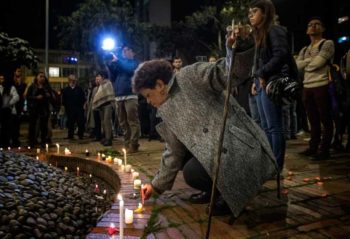
National mobilisation in support of the Peace Accord, November 2016, Bogotá D.C. – Marcha Patriótica’s communication team.
The justice system of the State and of the Peace Accords must contend with the Colombian far-right, which attempts to equate the crimes committed by the State with the crimes committed by insurgents. Simultaneously, the far-right seeks impunity for the military and the capitalist class while seeking punishment for the guerrillas. This tension shapes the long-term transition out of the war–a tension that resembles that of countries that struggle to emerge from dictatorships into democracy.
The Peace Accords did not issue a full amnesty law. Rather, the Accords established a model that would provide both victims and perpetrators with the ability to account for their actions and their pain. However, this model is constrained by the power dynamics in Colombia, which favour the dominant classes. For example, the victims’ organisations have a greater capacity to define what happened during the war. Meanwhile, one way that the dominant classes assert their viewpoint is to insist that the crimes of the State are equivalent to the crimes of the insurgents; this is despite the fact the agents of the dominant classes–both in the State and in the para-military groups–have the largest responsibility for the war crimes and have used the long war to enrich themselves.
The process of seeking justice is powerful because it is able to confront the truth about who financed the paramilitaries, a truth that could be used to dismantle these deadly actors and that therefore could generate the conditions for security that might lead Colombia to deepen the democratic process.
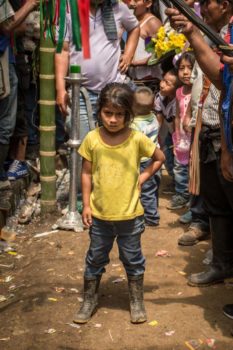
National Indigenous March, May 2016, Department of Cauca.
Marcha Patriótica’s communication team.
In the Present, Towards the Future
In Colombia, peace is disputed. This conflict implies a complete shift in the gravitational axis of politics from war to peace. The six-point programme of the Peace Accords has become an agenda for anti-neoliberal struggles, including a way to discuss other popular demands. The agreement charts out a path towards a democratic opening that is grounded in the removal of violence from politics, notably the idea that the insurgents are criminals or terrorists (which had previously blocked any serious political negotiation). The Accords raise the discussion of inequality and poverty to the forefront. This is especially important for rural areas, where the extreme appropriation of wealth is concentrated. Through the agreement in Havana, the political forces have agreed to recognize the misery in the country and to create reparations for the millions of people who have been impacted negatively by the war. Preserving the vitality of popular movements and their communities has been recognised as fundamental for building a genuine pathway to democratic change.
The Colombian government–controlled by the far-right–acts against the Peace Accords. It uses institutional and bureaucratic mechanisms to delay the implementation of the six-points of the Agreement, and it refuses to dialogue with the ELN. The government is afraid of a situation of peace because this would necessitate dismantling the system of domination that has been cemented through the repression of the popular movements.
The benefits of the war are not merely for the Colombian far-right; they are transnational, with the United States and other far-right entities across Latin America driving a geopolitical project of the right in the hemisphere. The establishment of peace would open up the possibility to challenge the domination of the ruling class. It would also challenge the agenda to destabilise the various progressive projects in the region, including the attempt by blockade and military intervention to overthrow the revolutionary process in Venezuela. Both the implementation of the agreements in the 2016 Peace Accords and the realization of an agreement with the ELN would allow for substantial advances by the popular movements and by the anti-neoliberal struggles for the political and economic transformation of the country (although not without contradictions and obstacles). Proof of this is already available, as large cities in the country have voted in various progressive and independent political forces into power and have limited the traditional power bloc, which includes the far-right.
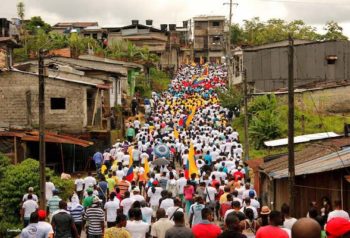
Mobilisation in the Department of Cauca.
Peasant Association of Catatumbo — Ascamcat.
The failure of the State to comply with the Peace Accords is aimed to create fractures in the popular movements. It is already clear that the State has a strategy to engender divisions amongst the movements in terms of their view of the way forward. As long as there is no peace between the State and all of the guerrilla groups, the strategy of State domination will continue, subordinating people both to inequality and poverty as well as to coercion through the State apparatus and the paramilitary forces. The systematic death of social leaders of popular struggles points to the methods by which the State and the paramilitary forces generate fear and rage, and then seek to produce a violent response to justify their violence in the first place. The ruling bloc is keen to retain the official narrative of the war, where the government and the paramilitaries are on the good side of history, whereas the popular struggles are placed on the bad side of history.
References
- Environmental Justice Atlas (2019). ejatlas.org
- Government of Colombia. Office of the High Commissioner for Peace [Final Agreement to End the Armed Conflict and Build a Stable and Lasting Peace.] especiales.presidencia.gov.co
- Ministry of Foreign Relations of Colombia Acuerdo de Donación de Objetivos de Desarrollo. Enmienda # 12. [Grant Agreement of Development Goals. Amendment 12] (2015). apw.cancilleria.gov.co
- Calderón, Javier. Injerencia judicial e impunidad en Colombia y Guatemala [Legal Intervention and Impunity in Colombia and Guatemala] (2019). celag.org
- Censo Agrario. Censo nacional Agropecuario [National Agriculture Census] (2015). dane.gov.co
- Cepeda, Iván Genocidio Político: el caso de la Unión Patriótica en Colombia [Political Genocide: The Case of Unión Patriótica in Colombia] (2006). corteidh.or.cr
- Centro de Investigación y Educación Popular (CINEP). Informe DDHH 2019: Violencia camuflada: la base social en riesgo [2019 Report on Human Rights. Camoflaged violence: The Social Base at Risk] (2019). cinep.org.co
- Euronews (en español). El que fuera número 2 de las FARC “Iván Márquez” anuncia que retoma las armas [‘Iván Marquez’, Second-in-Command at the FARC, announces that He Will Take Up Arms] (2019). youtube.com
- Colectivo de Abogados Alvear Restrepo-CAJAR Desplazamiento y restitución de tierras [Displacement and Land Restitution] (2015). colectivodeabogados.org
- Indepaz. Todas las voces todos los rostros. Informe de derechos humanos sobre la situación de líderes/as y defensores de derechos humanos en los territories. Actualización a mayo de 2019 [All of the Voices, All of the Faces. Report on the Human Rights of Social Leaders and Defenders of Human Rights in the Territories]. (2019). indepaz.org.co
- Kroc Institute for International Peace Studies. Tercer informe sobre la implementación del Acuerdo de Paz [Third Report About the Implementation of the Peace Accord] (2019). kroc.nd.edu
- González, Casanova Pablo. “Democracia, neoliberalismo y la lucha por la emancipación” [“Democracy, Neoliberalism, and the Struggle for Emancipation”] (2013). Desacatos. núm. 42, mayo-agosto, 2013, pp. 203- 213. Centro de Investigaciones y Estudios Superiores en Antropología Social Distrito Federal, México. redalyc.org
- Lajtman, Tamara and Arias Barona, Christian. Guerra infinita: EE. UU. y las drogas en Colombia [Infinite war: The United States and Drugs in Colombia] (2019). celag.org
- Molano, Alfredo “Conflicto Social y Rebelión Armada”, en Ensayos críticos de la Comisión Histórica del Conflicto Armado y sus Víctimas (CHCV) [“Social Conflict and Armed Rebellion”, in Critical Essays from the Historical Commission on the Conflict and its Victims (CHCV)] (2015). Bogotá, editorial. Gentes del Común.
- Oxfam. A Snapshot of Inequality, What the latest agricultural census reveals about land distribution in Colombia. (2017). oxfam.org
- Romano, Silvina and Calderón, Javier. Impactos del plan Colombia: otro éxito made in América [The Impacts of Plan Colombia: Another Success Made in America] (2017). redh-cuba.org
- Seoane, José. “Ofensiva neoliberal y resistencias populares: una contribución al debate colectivo sobre el presente y el futuro de los proyectos emancipatorios en Nuestra América” [The Neoliberal Offensive and Popular Resistances: A Contribution to the Collective Debate about the Present and the Future of Emancipatory Projects in ‘Our America’] (2016). Revista Debates Urgentes N° 4. ticsymovimientos.wordpress.com
- Security Assistance Monitor (s/f.). Security Aid (Colombia). securityassistance.org
- UNDOC. Informe de monitoreo de cultivos de uso ilícito en Colombia [Survey of territories affected by illicit crops 2019] (2019). unodc.org
- Marcella, Gabriel; Wilhelm, Charles. Plan Colombia: Some differing perspectives. (2001). globalsecurity.org.

